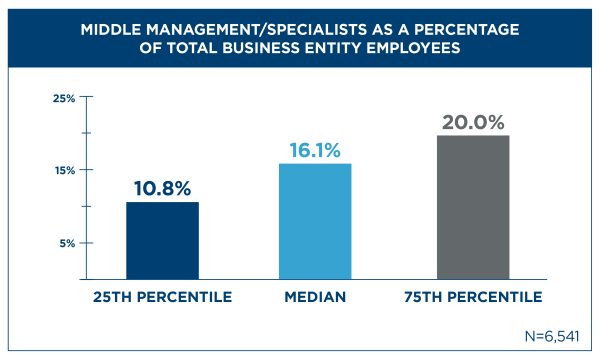
When organizations are looking to reduce headcount, they often begin at the management level and with middle management in particular. While reducing the number of middle managers in your organization can help you save labor costs more quickly, cuts to middle management can also be counterproductive if they leave you without the resources you need to pursue your business strategy and goals.
APQC finds that about one out of every ten employees working in a 25th percentile organization are middle managers. At the 75th percentile, one out of every five employees works in middle management.
For better or worse, there is no best practice or ideal number of middle managers to have. The optimal number for you will depend on factors that are unique to your organization like your size and the type of work you carry out.
While there is no “right” number of middle managers, there are risks associated with having too many or too few. When an organization has too many middle managers, for example, it might have more layers (i.e., levels of management) than it really needs. Along with higher payroll costs, this often means that decisions take longer and teams are less agile. Because management spans are smaller, there is also an increased risk of micromanagement—which can quickly lead to employee disengagement and dissatisfaction left unchecked.
Having too few managers carries its own risks. For example, if an organization makes drastic cuts to management, it will increase the workload on remaining managers, who may then struggle to keep up. Fewer managers also means that line level employees will have fewer opportunities for advancement and promotion, which carries the risk that they will seek these opportunities outside of your organization. Relatedly, the managers that you do have may not have the capacity to help employees develop or manage their performance adequately.
If you’re trying to determine the ideal number of middle managers for your organization, you can use the cross-industry metrics above as a starting point—but don’t stop there. To really know where you stand, it’s important to compare yourself to organizations of a similar size and your industry peers. Some industries like finance have higher levels of risk and are more heavily regulated, which means they require more oversight (and thus more management) relative to other industries.
It is also critical to consider your organizational life cycle stage and try to benchmark against organizations that are in a similar stage. If your organization is in an aggressive growth phase, for example, it doesn’t make sense to compare yourself to a social media company that is looking to move in the opposite direction with massive headcount reductions.
More broadly, you’ll want to keep your business strategy and goals in mind as you consider where you stand relative to others. If you are planning to invest heavily in learning and development to close skills gaps, for instance, now might not be the best time to reduce management headcounts significantly. On the other hand, if you need to reduce labor expenses to free up cash for other investments, a lower management headcount may make sense for you.
Make Cuts Like a Surgeon—Not a Lumberjack
There is no magic number of managers to have, but there are definitely better and worse ways to approach your management headcount.
Some organizations make cuts like a lumberjack with an axe, chopping widely and potentially damaging healthy growth that would actually benefit the organization. Smart companies cut like a surgeon with a scalpel to strategically remove excess headcount only from areas that no longer need it or that have unproductive growth. Consider your industry, strategy, and goals to think more critically about where you stand and whether you have the number of managers that is right for you.
